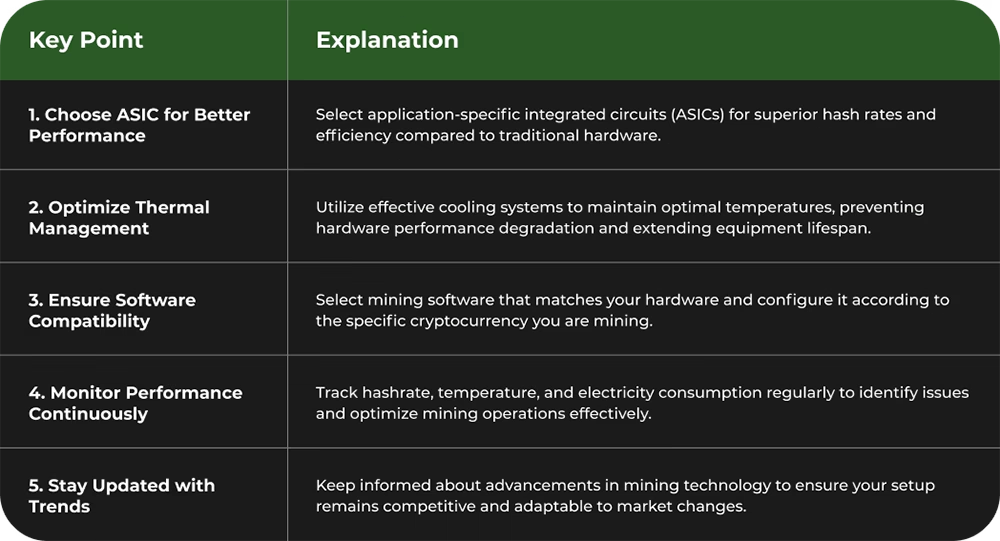Building a cryptocurrency mining rig is more than just plugging in a few parts and hoping for the best. Most people think mining is as simple as hitting ‘start’ on a computer, but the reality is much more technical. In fact, using specialized ASIC hardware can deliver hash rates thousands of times higher than standard PCs, which can make or break your profits. Knowing where to begin is the most important step if you want any shot at real mining success.

Selecting appropriate mining hardware represents the foundational decision in establishing a successful cryptocurrency mining operation. Your chosen hardware directly influences mining efficiency, electricity consumption, and potential profitability. Modern mining requires strategic hardware selection that balances performance, cost, and energy requirements.
When approaching hardware selection, miners must prioritize specialized equipment designed specifically for blockchain computational tasks. Application-specific integrated circuits (ASICs) have become the gold standard for serious cryptocurrency mining, offering substantially higher computational power compared to traditional computer processing units. These dedicated machines are engineered to solve complex mathematical problems with remarkable speed and precision.
Evaluating mining hardware demands careful consideration of several critical metrics. Hash rate represents the primary performance indicator, measuring the number of computational attempts a machine can execute per second. Higher hash rates translate directly into increased mining potential and likelihood of successfully validating blockchain transactions. Electricity consumption represents another crucial factor, as energy costs can significantly erode potential mining profits. Modern miners seek hardware that delivers an optimal balance between computational power and energy efficiency.
Investors should also consider the hardware’s adaptability and potential longevity. Cryptocurrency mining technology evolves rapidly, making flexibility and upgradability essential considerations. Read more about mining technology trends to understand the dynamic landscape of mining equipment.
Key hardware selection criteria include:
Successful mining hardware selection requires comprehensive research, budget alignment, and a forward-looking perspective on technological developments in blockchain computational infrastructure.
This table provides an at-a-glance comparison of major mining hardware options based on features described in the article, supporting your hardware selection decision.

Assembling a mining rig requires meticulous planning, precision, and technical understanding of computational hardware configurations. This critical stage transforms individual components into a powerful cryptocurrency mining system capable of generating consistent blockchain rewards. Successful assembly demands careful component selection, strategic placement, and comprehensive electrical and thermal management.
Beginning the assembly process requires creating a stable workspace with proper electrical grounding and sufficient lighting. Static electricity represents a significant risk during hardware installation, so using an anti-static wrist strap or working on a non-conductive surface becomes essential. Miners should organize components systematically, ensuring compatibility between motherboard, processor, graphics cards, power supply, and cooling mechanisms.
The motherboard serves as the central nervous system of your mining rig, determining potential computational capacity and expansion capabilities. When selecting a motherboard, prioritize models with multiple PCIe slots to accommodate several graphics processing units (GPUs). Robust power delivery systems and enhanced cooling features distinguish professional-grade motherboards suitable for continuous mining operations.
Power supply selection represents another critical decision in rig assembly.
Mining rigs consume substantial electrical resources, requiring high-wattage power supplies with efficient energy conversion ratings. Modular power supplies offer enhanced cable management, reducing internal heat generation and improving overall system reliability. Explore advanced mining infrastructure strategies to optimize your computational setup.
Critical assembly considerations include:
Comprehensive testing after initial assembly confirms the mining rig’s operational status. Systematic verification through benchmark tests and stress simulations helps identify potential hardware conflicts or performance limitations before full-scale deployment.
Below is a checklist table to help ensure your mining rig is properly assembled, configured, and ready for optimal performance before full-scale deployment.

Installing the appropriate mining software transforms your carefully assembled hardware into a functional cryptocurrency mining system. This critical step bridges physical infrastructure with blockchain network participation, enabling your rig to solve complex mathematical problems and generate potential digital currency rewards. Successful software installation requires precision, understanding of specific cryptocurrency protocols, and strategic configuration.
The software selection process begins by identifying the specific cryptocurrency you intend to mine. Different blockchain networks require unique mining applications, each with specialized algorithms and computational requirements. Bitcoin mining software differs significantly from applications designed for Ethereum or alternative cryptocurrencies, making targeted selection crucial for operational efficiency.
Initial software installation involves downloading reputable mining applications from verified sources. Miners must exercise extreme caution, as the cryptocurrency ecosystem contains numerous malicious software packages designed to compromise computational resources. Recommended mining applications include open-source solutions like CGMiner, BFGMiner, and specialized applications tailored to specific hardware configurations. Verifying software authenticity through developer community reviews and cryptographic signatures helps mitigate potential security risks.
Configuration requires detailed parameter setup, including wallet addresses, mining pool selections, and performance optimization settings. Precise network connection parameters determine your mining rig’s ability to communicate effectively with blockchain infrastructure. Explore advanced mining software strategies to enhance your understanding of complex software deployment techniques.
Critical software installation considerations include:
Successful software installation concludes with comprehensive system testing, including hashrate verification, temperature monitoring, and consistent blockchain network connectivity.

Miners should anticipate potential configuration adjustments to optimize performance and adapt to evolving cryptocurrency mining landscapes.
Connecting and configuring your mining rig represents a pivotal moment in transforming hardware into a functional cryptocurrency mining system. This step bridges physical infrastructure with digital networks, enabling your computational setup to interact seamlessly with blockchain ecosystems. Successful configuration demands precision, technical understanding, and strategic network management.
Network connectivity begins with establishing a stable internet connection capable of supporting continuous data transmission. Ethernet connections provide more reliable performance compared to wireless networks, minimizing potential interruptions during mining operations. Dedicated network interfaces ensure consistent communication between your mining rig and cryptocurrency mining pools, reducing latency and maximizing computational efficiency.
Initial configuration requires accessing your mining rig’s network settings, typically through built-in operating system interfaces or specialized mining management software. Miners must configure dynamic IP addressing to facilitate automatic network integration, ensuring seamless connectivity and reducing manual intervention requirements. Configuring router settings to prioritize your mining rig’s network traffic can further optimize performance and reduce potential communication bottlenecks.
Security represents another critical consideration during network configuration. Implementing robust firewall rules, disabling unnecessary network services, and utilizing virtual private network (VPN) technologies can protect your mining infrastructure from potential cyber threats. Explore advanced network security strategies to safeguard your cryptocurrency mining investments.
Critical network configuration considerations include:
Successful rig connection concludes with comprehensive network testing, including ping response verification, consistent mining pool connectivity, and real-time performance monitoring. Miners should anticipate potential configuration adjustments to maintain optimal network performance and adapt to evolving blockchain infrastructure requirements.
Initiating your mining operation transforms theoretical preparation into active cryptocurrency generation. This pivotal stage requires strategic execution, continuous monitoring, and adaptive management to maximize computational efficiency and potential financial returns. Successful mining demands constant vigilance and proactive performance optimization.
Launching your mining software initiates the blockchain interaction process, where your computational resources solve complex mathematical problems to validate transactions and generate potential cryptocurrency rewards. Selecting an appropriate mining pool becomes crucial, as collaborative mining increases the probability of consistent earnings by combining computational power with other miners worldwide.
Real-time performance tracking represents the cornerstone of effective mining operations. Advanced monitoring software provides comprehensive insights into hashrate, temperature metrics, power consumption, and potential system bottlenecks. Miners must develop a systematic approach to interpreting these performance indicators, recognizing subtle variations that might signal potential hardware stress or operational inefficiencies.
Electricity consumption and thermal management emerge as critical considerations during continuous mining operations. Maintaining optimal hardware temperature prevents potential performance degradation and extends equipment lifespan. Implementing robust cooling solutions and monitoring system temperatures in real-time helps mitigate risks associated with prolonged computational stress. Explore advanced mining performance strategies to enhance your understanding of complex mining ecosystems.
Critical performance monitoring elements include:
Successful mining operations require continuous learning and adaptation. Miners should remain flexible, prepared to adjust configuration settings, upgrade hardware components, and pivot between different cryptocurrency mining strategies as market conditions evolve. Regular software updates, firmware upgrades, and performance benchmarking ensure your mining rig remains competitive in the dynamic blockchain ecosystem.
Verifying mining results and optimizing settings represents the culmination of your cryptocurrency mining setup, transforming initial hardware and software configurations into a refined, high-performance computational system. This critical stage requires systematic evaluation, data-driven analysis, and strategic adjustments to maximize mining efficiency and potential financial returns.
Initial verification begins by analyzing comprehensive performance metrics generated by mining software.

Hashrate consistency, share acceptance rates, and generated cryptocurrency earnings provide fundamental insights into your mining rig’s operational effectiveness. Miners must develop a nuanced understanding of these metrics, recognizing subtle variations that indicate potential optimization opportunities.
Optimization involves a multifaceted approach to fine-tuning hardware and software configurations. Thermal management emerges as a crucial consideration, with miners needing to balance computational performance against potential heat-related degradation. Advanced cooling strategies, including custom airflow configurations and targeted thermal management, can significantly enhance overall system stability and longevity.
Electricity consumption represents another critical optimization parameter. Intelligent power management techniques can dramatically improve the economic viability of mining operations by reducing operational costs and maximizing computational efficiency. Explore advanced mining performance optimization techniques to enhance your understanding of complex mining ecosystems.
Critical optimization considerations include:
Successful mining optimization requires continuous learning and adaptation. Miners must remain flexible, prepared to implement firmware updates, adjust software configurations, and potentially upgrade hardware components. Regular performance benchmarking and staying informed about emerging blockchain technologies will ensure your mining infrastructure remains competitive in the rapidly evolving cryptocurrency landscape.
Are you tired of the challenges and complexity described in our step-by-step guide to mining rigs? Choosing the right hardware, managing energy costs, software setup, and ongoing optimization all present major pain points for new and experienced miners. Many readers want to maximize ROI but face setbacks with hardware selection, network stability, and maintaining optimal performance. Blockware Solutions understands these challenges and provides a better way to mine.
Take the guesswork out of your mining journey. Enjoy expert-hosted mining solutions with unmatched ROI tools and full concierge support. Stop worrying about hardware breakdowns and technical bottlenecks. Let Blockware Solutions handle every aspect so you can focus on growing your digital assets. Get started now by visiting Blockware Solutions and discover how easy and profitable Bitcoin mining can be. Transform your mining operation today with support from real professionals who know what it takes to succeed.
What is a mining rig?
A mining rig is a computer system specifically designed to mine cryptocurrency by solving complex mathematical problems. It consists of various hardware components such as a motherboard, graphics cards (GPUs), and power supply units that work together to process transactions on a blockchain network.
How do I choose the right hardware for my mining rig?
Selecting the right hardware involves considering important factors like hash rate (computational power), energy efficiency, initial cost, and the specific cryptocurrency you intend to mine. ASICs (Application-Specific Integrated Circuits) are commonly preferred for their high performance, while GPUs are versatile for different cryptocurrencies.
What software is needed to run a mining rig?
You need mining software compatible with the cryptocurrency you plan to mine. Popular choices include CGMiner and BFGMiner. The software enables your hardware to connect with the blockchain network, manage mining tasks, and facilitate the earning of cryptocurrency rewards.
How can I monitor the performance of my mining rig?
You can monitor the performance of your mining rig using specialized software that provides real-time data on hash rates, temperature, electricity consumption, and connectivity to the blockchain network. Regular performance tracking allows for adjustments to optimize mining efficiency.